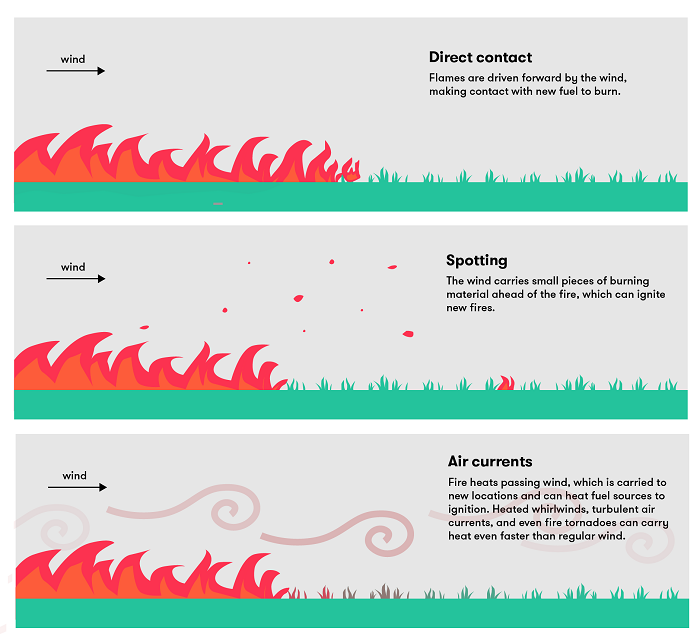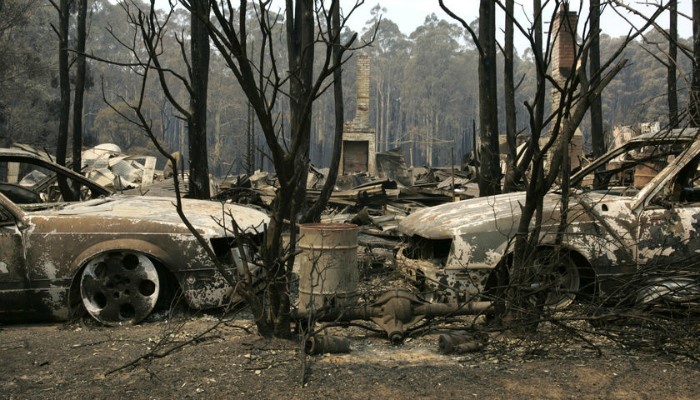
What to do if you are threatened by bushfires
January 7, 2020
As a proudly Australian company, it breaks our hearts to witness our beautiful land be devoured by flames. To date, we are lucky to have very few clients impacted by the fires but we wanted to help anyone who might be impacted or at least educate you as to what to do in this is ever an issue for you (and we hope it never is).
We would also like to say, as a family-owned business we truly believe you can replace property but not people and your family. Please always protect the lives of loved ones first.
The ABC has put together a comprehensive Survival Plan which is where we have sourced much of this information from.
Before a bushfire
- Fire agencies recommend that you develop a bushfire survival plan and discuss this with your family.
- Know the fire danger ratings and what they mean. Use them as your trigger to stay or leave the area.
- Don’t wait and see. It is extremely dangerous to leave after there are signs of fire in your area. Come up with a plan to decide when to leave, where you will go and how you will get there.
- Consider moving children, the elderly and people with illness or disability, as well as animals, away from danger as early as possible.
- If you live in or intend to travel to a high-risk bushfire area, know the location of the nearest bushfire safe place, meeting point or evacuation centre and how to get there.
- Check the frequency of the nearest ABC Radio station using our frequency finder and/or check ABC Emergency on Twitter and Facebook to stay up to date with conditions.
- Always notify your family and friends of your plans and intentions to stay or go.
- Make sure your bushfire survival kit is ready and you know of its location.
If you decided to leave your home, make sure you:
- Close doors and windows, fill sinks with water and move outdoor furniture away from the house.
- Pack food, water and your survival kit in your car, adding any final items.
- Turn off mains gas supply.
- Take your list of contacts in order to inform them of your departure and destination.
- Develop a back-up plan, including where you will shelter if you have not left early and it is unsafe to leave. This is a dangerous situation and you must know where you will seek shelter from radiant heat.
- Establish the location and route to your closest Neighbourhood Safer Place (NSP). NSPs are places of last resort. They may save your life but they do not guarantee safety.
- If you are able, identify several exits to ensure you can leave safely if your planned route is blocked.
- Make sure you are wearing protective clothing to shield you from deadly radiant heat.
If you decide to stay and defend your home:
- Fire agencies say defending your home requires at least two able-bodied, fit and determined adults.
- Both adults need to be sure they’re physically and mentally prepared to work in difficult conditions.
- Homes in an area with a Code Red or Catastrophic fire danger rating are difficult to defend, even if well prepared.
- Ensure your home is prepared by following a guide like this prepared by the Rural Fire Service in New South Wales. You should ring your state’s fire authority and ask for an assessment or advice.
- It is recommended that you have 10,000 litres of water for firefighting purposes as well as a firefighting pump and hoses.
- Other equipment needed includes a water sprayer, bucket, mop, shovel, torch and battery-powered radio.
- Ensure you have adequate protective clothing as outlined in the survival kit. Radiant heat is the biggest killer in a fire.
If you are travelling:
- Find out what bushfire safety plans are in place in the area where you are camping, caravanning or renting accommodation.
- Know the most up-to-date fire danger rating in the area via your ABC Local Radio station, on Twitter and Facebook, or checking with the local fire agency.
- Find the nearest Neighbourhood Safer Place when you are staying in a high-risk fire area and know alternative routes to leave your destination.
- Plan activities carefully on hot, dry and windy days. Contact the visitor information centres for safe tourist activities and locations.
- Pack your own emergency survival kit and have it accessible at all times.

(Supplied: Australian Academy of Science/Nova)
During a bushfire
Always inform family and friends of your movements.
Also, and only if it is safe to do so, contact your ABC Local Radio station via phone or social media to tell others what you can see. This will help the community with first-hand and reliable knowledge about what’s going on.
Radiant heat
Being outdoors during a bushfire means you risk exposure to radiant heat, which can kill a human without flames ever touching them.
Extreme temperatures from radiant cause death from heatstroke where the body’s cooling system fails, leading to heat exhaustion and heart failure.
Ensure you continue to stay cool and keep drinking water to stay hydrated.
If someone is affected by heatstroke, move them to a shaded area and try to cool them down. Call triple-0 and seek help immediately.
Seeking shelter
If you need to seek shelter due to a sudden change in your bushfire survival plans, fire agencies say the main priority is sheltering from radiant heat.
- It is recommended you seek shelter in a well-prepared home that can be actively defended, a private bunker built to regulation or at a community shelter or refuge.
- If sheltering in a building, make sure you have a point of exit in every room of the shelter.
- Maintain visibility so you know what’s happening with the fire outside.
- Take your survival kit and wear protective clothing to help guard against radiant heat.
- Leaving when a bushfire has arrived is extremely dangerous, but if you have no other option you can go to your local place of last resort — a ploughed paddock or the beach, dam or river — but don’t shelter in water tanks.
- Radiant heat can be blocked by a solid object such as a concrete wall or building which creates a barrier between you and the fire.
If defending your home:
- Everyone defending your home should wear protective clothing.
- Make sure all cars, farm equipment, caravans and portable gas cylinders are moved away from the house. Also remove doormats, outdoor furniture and all other flammable items.
- Ensure the mains gas supply is switched off, switch off air-conditioning units, and gas cylinders should be kept upright with their relief valve away from the building.
- Fill gutters with water and wet down around the building. Keep wet towels and rags nearby.
- Windows and doors should be closed and wet towels used to fill gaps under doors.
- It is recommended that you shelter inside until the fire front passes but still patrol for embers and extinguish them on landing.
- If your house catches alight, close the door to the room behind you. Never get caught in a room without an exit. If you must go outside, move onto burnt ground as soon as possible.
Driving
This is the last resort. Cars are a very dangerous place to be during a bushfire as they offer very little protection from radiant heat.
Driving somewhere will take longer than you expect and road conditions can become dangerous. There may be road closures, smoke, fallen trees and embers.
- Park behind a solid structure to block as much heat as you can. If this is not possible, pull over to the side of the road into a clear area, well away from debris that may ignite.
- Wind up your windows, close the vents, put on your hazard lights and headlights, leave the engine running and air conditioning on recirculate.
- Get down as low as possible below window level and cover up with a woollen blanket until the fire passes — if you have water, drink it.
- Get out of the car only once the fire has passed.
After a bushfire
- Stay tuned to your ABC Radio station, listen online or via the ABC Radio app, and/or check ABC Emergency Twitter and Facebook for updates and instructions from official agencies.
- If you have evacuated, do not return home until you are advised it is safe to do so.
- For those who have stayed and defended their homes, continue to wear your protective clothing and patrol your property for embers hours after the fire front has passed.
- Call your family and friends to let them know you are safe.
In case you become separated from loved ones, Red Cross manages Register.Find.Reunite, a national registration and enquiry service. When the service is activated, people can register at www.redcross.org.au or in person at an evacuation or relief centre. You can also use the website if you are unable to contact a loved one who may have been affected.

Property damage and your insurance
- Contact us on 07 3028 9494 as soon as possible so we can get you help straight away. Our dedicated Claims Team is here to help you.
- Your local fire service will help secure the premises until responsibility can be handed over to the owner/occupier or insurance company where possible.
- If your home is unsafe to occupy, notify the police and we can arrange temporary housing expenses or obtain an advance on your eventual settlement.
- It is the owner’s responsibility to secure a site following a fire. Make sure outside doors can be locked and that openings are covered against weather and entry. If you are the occupier, contact your landlord or real estate agent and inform them of the fire.
- Food, beverages, and medicines exposed to heat and smoke should be discarded.
- Please be careful walking around a site, there can be toxic chemicals lying in the ash or on surfaces that remain and debris can still be extremely hot.
Utilities
- Services such as telephones and supply of water, electricity and gas may be affected by the bushfire.
- If your house is damaged, your local fire service will contact the local council, gas, fuel and electricity suppliers to disconnect services as required.
- If any services have been disconnected, it is the owner’s responsibility to have the service checked and reconnected by the utility service provider. Do not attempt to reconnect services yourself.
Here is a list of Fire emergency services
- Queensland Rural Fire Service
- Queensland Fire and Emergency Services
- Rural Fire Service (NSW)
- Fire and Rescue Service (NSW)
- Country Fire Authority (VIC)
- Metropolitan Fire Brigade (VIC)
- Country Fire Service (SA)
- Northern Territory Fire and Rescue Service
- Department of Fire and Emergency Services (WA)
- Tasmanian Fire Service
- ACT Fire and Rescue
Please stay safe!
Source: https://www.abc.net.au/news/emergency/plan-for-an-emergency/bushfire/


